Top News
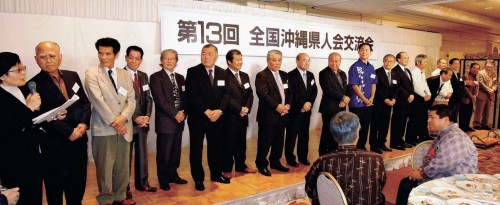
October 4, 2015 Ryukyu Shimpo
The 13th national Okinawa Kenjinkai exchange meeting was held on October 3 in Tokyo. About 230 representatives from 18 organizations and Okinawa Governor Takeshi Onaga attended the meeting.
The meeting is held by the Tokyo Okinawa Kenjinkai every two years, when representatives from organizations across the country get together in order to deepen their friendship.
Takeo Nakamatsu, the chairman of the Tokyo Okinawa Kenjinkai, said in his greeting speech that, “We should unite to block the building of a new U.S. base and resolve Okinawa’s problems.” As an Uchinanchu or Okinawan living in the mainland of Japan, he proudly made clear his opposition to base construction at Henoko.
The participants responded to his speech with applause.
Nakamatsu vowed to practice three things and urged others to do the same: first, he said, we should take pride in being Uchinanchu, second; we should unite in order to resolve Okinawa’s problems and third; we should not to allow a new U.S. base to be built.
He said, “The love for Okinawa inspires our actions. We want to promote Uninachu spirit to all of Japan from all of Okinawa in order to reach a nationwide consensus.”
Takehiro Oshiro, the chairman of the Hyogo Prefecture Okinawa Kenjinkai, said, “We, who live in the mainland, will support Governor Onaga who is struggling to resolve the issue, bearing Okinawa on his shoulders as he tries to reflect the will of the people. I hope you will donate to the Henoko Fund and support the governor.”
“The base issues are not ideological. They come from a need to rectify the current situation where the governments of Japan and the United States continue to place 74 percent of U.S. military facilities in Japan on Okinawa, which accounts for 0.6 percent of the area of Japan,” Governor Onaga stressed.
He said, “I will continue to say ‘Do not press the U.S. bases only on Okinawa, if you favor the Japan-U.S. security,’ even though some frictions take place.”
Masaru Sato, a former Foreign Ministry chief analysis officer and his mother from Kumejima Island, gave a lecture titled “Okinawa identity.”
(English translation by T&CT)
Go to Japanese
September 30, 2015 Sakae Toiyama of Ryukyu Shimpo reports from Washington D.C.
On the afternoon of September 28, the governments of the United States and Japan concluded a supplementary environmental agreement regarding the performance of on-site surveys within US military base compounds. Japanese Foreign Minister Fumio Kishida and US Defense Secretary Carter met at the Pentagon to talk and sign the agreement.
One of the main characteristics of the agreement is that it stipulates that when US military facilities or areas are returned to Japan, the United States will allow Japan to perform on-site environmental surveys up to seven months prior to the date of return. This is the first time a supplementary agreement has been added to the Status of Forces Agreement since it came into effect in 1960. The Status of Forces agreement defines the parameters of US base operations in Japan. The new agreement went into effect the same day it was signed.
However, since the agreement does not oblige the US to allow Japan to perform an on-site survey when Japan requests permission to do so, some question the efficacy of the agreement.
The two governments reaffirmed their commitment to cooperate in proceeding with the relocation of Marine Corps Air Station Futenma to Henoko, Nago. With Japan’s new security bills being passed earlier this month, they also agreed to further strengthen the US-Japan alliance based on the new guidelines for US-Japan defense cooperation, revised in April of this year.
The supplementary agreement states that Japanese authorities will be allowed to enter US base compounds (1) in the event of an accident involving leakage of a substance that could have an impact on the environment, and (2) in the event that an on-site survey is necessary to prepare base land for return, including surveys on cultural artifacts. It also stated that the US military will strictly adhere to the Japan Environmental Governing Standards (JEGS).
Discussions may commence on the question of an on-site survey following the request of either the US or Japan. Surveys may include excavation surveys.
-Governor deems agreement insufficient
Upon receiving the news that the US and Japanese governments had concluded a supplementary environmental agreement, Governor Takeshi Onaga lauded the conclusion of the agreement itself, but remarked, “The agreement does not include the Okinawa prefectural government’s request that on-site surveys be conducted starting at least three years prior to land return. It says that the US military will pay consideration to Japanese requests to enter base compounds in the event of an accident, but permission could depend on US military operational demands. There are parts of the agreement that remain insufficient.”
(Translation by T&CT and Sandi Aritza)
Go to Japanese
October 1, 2015 Sakae Toiyama of Ryukyu Shimpo reports from Washington D.C.
On September 29, the US Congress Joint Committee on Armed Services presented the final version of the National Defense Authority Act (NDAA) for Fiscal Year 2016 (October 2015-September 2016). The previous House of Representatives bill called Henoko “the only option for the Futenma Replacement Facility.” This provision was retracted, and this phrase was not included in the text of the bill sent back to the House by the Senate. Nago City Mayor Susumu Inamine, Okinawa prefectural leaders, representatives of Okinawa in the National Diet, prefectural assembly members and business leaders had been challenging the wording “the only,” and appealing for this phrase to not be used in the final version of the NDAA.
In part of the bill that passed the House, the joint committee stated that progress continues to be made in the US and Japan to fulfill the agreement made by those in attendance of the 2+2 (United States-Japan Security Consultative Committee) meeting in April. This statement demonstrates the joint committee’s wish to move forward with the current plan of relocation to Henoko.
The phrasing “the United States supports recent changes in defense policy, including the adoption of collective self-defense” in the House bill was also not found in later versions. In relation to Japan’s national security policy, the words “the United States welcomes Japan’s decision to contribute more proactively to regional and global peace and security” were removed, as well.
In June of this year Okinawa’s Governor Takeshi Onaga and accompanying delegates visited the United States and appealed to US congressmen. During the visit, they requested changes to the House-passed NDAA phrasing in regards to the Henoko relocation. In July, Okinawa prefectural leaders and Diet members submitted a document to the US Congress appealing for removal of the specific reference to Henoko in the final version of the bill.
(English translation by T&CT and Erin Jones)
Go to Japanese
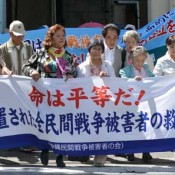
October 1, 2015 Ryukyu Shimpo
On September 30, a trial hearing of a case involving 79 survivors and survival family members embroiled in the Battle of Okinawa has concluded at Naha District Court. The plaintiffs filed for damages against the Japanese government. The decision will be given on March 16, 2016. Prior to the final defense plea, the plaintiffs handed over the medical certificates of 37 people, who were diagnosed with Post-Traumatic Stress Disorder (PTSD) and other psychiatric issues caused by war experiences, to the court. According to the lawyers, it is the first time in which war victims pursuing damages from the state have submitted medical certificates about psychological damage.
The government claims that the war occurred when Okinawa was under the Meiji Constitution. On that basis, it rejects the plaintiffs’ argument and claims the state is exempt from responsibility for compensation. It also argues for ‘tolerance theory’ – the idea that the governed should equally tolerate damages caused during the war.
At the final hearing, lead lawyer Shigeru Zukeyama stressed, “War damage is the biggest infringement of basic human rights.” Pointing out the particularity of the Battle of Okinawa, including atrocities by Japanese soldiers, Zukeyama counterargued that the Meiji Constitution also guaranteed protection of the lives and bodies of subjects.
At a press conference, one of the leading plaintiffs, Chieko Nozato said, “I question a government attitude that does not heal the wounds of war. I hope the decision will be for citizens.” 78-year-old Yoko Kamiya, who was diagnosed with PTSD, made stated, “I have never forgotten the war. I hope the judge will understand the suffering and pain of victims.”
(English translation by T&CT and Megumi Chibana)
Go to Japanese
October 2, 2015 Ryukyu Shimpo
The Yamashina Institute for Ornithology in Chiba Prefecture announced that a seabird found at the Kanucha Golf Course in Abu, Nago City was a Bridled Tern that had flown from Nakhiloo Island in Iran. The bird was found in October last year and died after it was taken into care. The island is located 7, 450km from Nago City. This is the first time a wild bird has been confirmed to have moved between Iran and Japan, according to the institute.
The Bridled Tern was found a day after Typhoon Vongfong passed, and the bird was confirmed dead when it was carried to a veterinary hospital. It is thought that the bird was exhausted due to the typhoon that carried it to land. The institute contacted the Ministry of Environment in Iran to confirm that the bird was released by a research team in the country in July 2013 after the team attached a leg ring on it.
Species that breed in Iran are known to spend winter in regions from India to eastern Africa. Although its biology is not yet fully known, usually the species moves between north and south. The Deputy Director General of the institute, Kiyoaki Ozaki said, “There is not much known about the species, including its biology.”
(English translation by T&CT and Sayaka Sakuma)
Go to Japanese
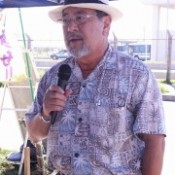
October 1, 2015 Ryukyu Shimpo
In front of the gate at Camp Schwab in Nago, citizens continue to stage a sit-in-protest against the construction of an alternative base for U.S. Marine Corps Futenma Air Station, which the Japanese and US governments want to relocate to Oura Bay, off the coast of Henoko. The Shima Gurumi Association was created by Okinawan business leaders and intellectuals. Around 9 a.m., the co-representative of the Shima Gurumi Association Morimasa Goya, who is also a Kanehide Group Chairman, visited the protest site, and cheered on the protesting citizens.
Goya said, “Although I want Okinawa Governor Takeshi Onaga to revoke the former governor’s approval of the landfill in Henoko soon, I would like Onaga to be careful of how the Japanese government responds to Okinawa’s move.”
Employees hired by the Okinawa Defense Bureau were confirmed to have installed floats off the coast of Henoko.
(English translation by T&CT)
Go to Japanese
September 19, 2015 Ryukyu Shimpo
Taketomi Town Office will mark ‘Iriomote Yamaneko no Hi’ (Iriomote Wild Cat Day) on April 15 of every year. This year was the 50th anniversary of the discovery of the Iriomote Wild Cat, a special national treasure. The wild cat can only be found on the island.
On September 17, the town assembly passed a bill to create ‘Iriomote Wild Cat Day”, as part of efforts to conserve and take care of the wild cat, starting on April 15 next year. Animal experts announced on April 15, 1965, that the cat was a newly found species. The bill stresses that the Irimote Wild Cat Day helps to raise awareness and express people’s determination to develop the community while coexisting with the Wild Cat.
(English translation by T&CT, Hitomi Shinzato)
Go to Japanese
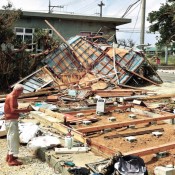
October 1, 2015 Ryukyu Shimpo
On September 30, the Okinawa Prefectural Government (OPG) decided that it would apply the Disaster Relief Act to Yonaguni Island, where more than 300 houses were damaged by Typhoon No.21 or Super Typhoon Dujuan.
The typhoon registered a maximum instantaneous wind speed of 81.1 meters per second on the island.According to the act, the national government will pay more than half of the costs, including those to build shelters, in order to reduce the cost burden on the municipal office. The act applied to the island will date back to September 28, when the typhoon struck the island and left major damage.
According to the municipal office, 322 houses were damaged, including 10 that were completely destroyed. As of September 30, the total damage bill exceeded 100 million yen, including about 83 million yen in damages to sugar cane and other crops, livestock, agricultural and school facilities. According to the OPG, about 40 utility poles collapsed, and a concrete detached breakwater was damaged.
Governor Takeshi Onaga stated at the prefectural assembly, “We are working to investigate the damage situation caused by the typhoon, and we will take disaster-recovery measures.”
It is the 12th time the disaster relief act has been applied in Okinawa since the landslides took place in Naha and Nakagusuku in 2006.
Fixed phones in the municipal office and mobile phones at many areas of the island have been resumed. According to the Okinawa Electric Power Company, as of October 1, at Kubura, Higawa and Sonai districts, 100 households still suffer from power outages.
On September 30, the government sent an investigation team to Okinawa. The team members received a situation report from Vice Governor Mitsuo Ageda. They visited Yonaguni Island to investigate typhoon damage on October 1.
(English translation by T&CT)
Go to Japanese
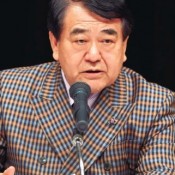
September 10, 2015 Ryukyu Shimpo
President of the Japan Research Institute, Jitsuro Terashima, gave a talk titled “Summer 70-Years After the War, Strategic Perspective on Okinawa: beyond Security Legislation” on September 9 at Palette Civic Theater in Naha City.
Three hundred and forty people attended the event to hear Terashima talk. In his speech, Terashima overviewed the history and contemporary society of Okinawa, and discussed its future. Terashima analyzed the result of the Okinawa gubernatorial election held last year and other various elections, pointing out the change in the public sentiment of Okinawans facing the military base issues. Terashima stated, “Okinawa has been changing its direction from being the island of military to being a hub that facilitates mutual understanding and collaboration among East Asia.”
On the other hand, Terashima addressed a lack of awareness outside of the prefecture. He said, “There are limits with solutions argued in the context of merely reducing the burden of military or increasing the Okinawa promotion budget.”
Terashima mentioned how Germany managed to revise the Status of Forces Agreement (SOFA) as well as reduce U.S military bases in the country. Further arguing for the need to gradually reduce U.S. military in Japan as well as revise the US-Japan SOFA, Terashima stressed, “Japan would no longer exist as a nation if we did not claim our sovereignty by reducing U.S. military and revising the U.S.-Japan SOFA.” Referring to the revision of an unequal treaty made during the Meiji era, Terashima insisted, “This is our treaty revision today.”
(English translation by T&CT and Sayaka Sakuma)
Go to Japanese
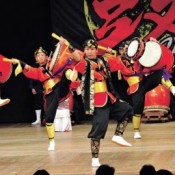
September 23, 2015 Ryukyu Shimpo
The 2015 World Eisa Competition sponsored by Urasoe City held its main event, the original eisa contest, on September 22 at National Theatre Okinawa in Urasoe City. Tijinshu Wakat-da from Urasoe City won the group’s grand first prize. CHURASA from Itoman City, Naha Daiko from Naha City, and Original Eisa Takanabe Shinkancha from Miyazaki Prefecture won the second, third, and a special award respectively.
Nineteen groups consisting of 13 groups from Okinawa, three groups from other prefectures, and three groups from abroad performed in the grand prize category. An 18-year old team member from Tijinshu Wakat-da, Eiki Shiroma, shared his delight, commenting, “We danced synchronizing our feelings and hearts.”
There was also an Eisa Conference to discuss new eisa styles at Yui no Machi at Urasoe Industry Promotion Center on September 23.
(English translation by T&CT and Sayaka Sakuma)
Go to Japanese
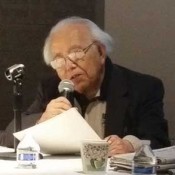
September 29, 2015 Ryukyu Shimpo Sakae Toiyama reports from Washington DC
On September 27, the Association of Comprehensive Studies for Independence of the Lew Chewans (ACSILs), an organization engaged in interdisciplinary research aiming to achieve Ryukyuan independence from Japan, held a forum at New York University in New York. The five speakers presenting at the forum were ACSILs co-representative and Ryukoku University professor Yasukatsu Matsushima, University of Illinois professor emeritus Koji Taira, Okinawa Association of America president Shingi Kuniyoshi, Okinawa International University professor Masaki Tomochi, and University of California, Riverside professor Annmaria Shimabuku. The speakers discussed the issue of Ryukyuan independence from various angles.
Professor Matsushima described the history of US base construction in Okinawa and the current situation, and then discussed the grounds for and methods to achieve independence. He stated, “In order to remove all the US bases from our island, Okinawa should become an independent nation.”
Professor Taira, an economist and proponent of independence, talked about the history of the Ryukyus and discussed Ryukyuan independence from a global perspective. Kuniyoshi, who has worked on environmental clean-up of U.S. base land after it has been returned, talked about how the U.S. Department of Defense deals with environmental clean-ups, including the legal framework, disclosure of information, and record-keeping. He noted as issues relating to the U.S. bases in Okinawa the lack of an environmental restoration program and the need to better manage dangerous substances and deal with pollution caused by leakages.
Professor Tomochi discussed the history and culture of the Ryukyus as an independent nation. Referring to the current issues of the relocation of MCAS Futenma to Henoko, Nago and the forced deployment of the MV-22 Osprey, he emphasized that today, Okinawa remains a colony of the United States and Japan.
Professor Shimabuku advocated for Okinawan sovereignty from the perspective of legal philosophy. She proposed the potential for independence based on the idea of relocating MCAS Futenma outside of Okinawa and the movement of the Okinawan diaspora.
Forum attendees asked questions about the proportion of people in Okinawa who support independence, the prevalence of Uchinaaguchi speakers in Okinawa, and the possibility for solidarity with Ainu people.
(Translation by T&CT and Sandi Aritza)
Go to Japanese







 Webcam(Kokusai Street)
Webcam(Kokusai Street)


